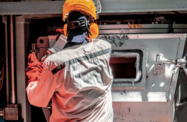Morocco: Stimulating growth in industry
 En Français
En Français
According to the most recent figures, Morocco’s secondary sector has seen some encouraging growth in 2012, despite difficult global economic conditions, thanks in large part to the production of phosphate rock and derivatives. However, with pressure to improve employment figures and increase household consumption, the government is soliciting additional foreign investment in specific manufacturing segments to help boost industrial activity in the medium term.
Morocco is one of the world’s largest phosphate producers and the sector comprises the largest chunk of the country’s industrial GDP. In the first three quarters of 2012, the volume of unprocessed phosphate exports fell from 7.04m tonnes to 6.91m tonnes, but their value grew from Dh9.26bn (€833.62m) to Dh9.71bn (€874.13m) by the end of September. Exports of phosphate derivatives increased from 4.72m tonnes in 2011 to 4.87m tonnes in 2012, boosting export value from Dh26.43bn (€2.38bn) to Dh27.32bn (€2.46bn) through the end of September.
Phosphates and derivatives are the country’s biggest foreign exchange earners and represent roughly one-quarter of total exports. While the volume of foreign demand has dipped slightly due to the global economic context, rising commodity prices have buoyed sector turnover nonetheless.
The state-owned Office Chérifien des Phosphates (OCP), which dominates the phosphates sector, has engaged in a Dh130bn (€11.7bn) investment plan aimed at modernising sector infrastructure and boosting production capacity from 30m tonnes to 50m tonnes by 2020. Growth in this industry has already attracted considerable investment from foreign institutions; for example, the conclusion of financing agreements with the European Investment Bank, the African Development Bank and the French Development Agency between May and October 2012, for total loans of nearly €400m, should help to strengthen sector productivity in the near term.
To meet these production goals, the OCP plans to oversee the construction of four new mines in Khouribga and Benguérir, expected to provide an additional capacity of 20m tonnes of phosphate rock per year. Work is also underway on a 300-km mineral pipeline system with the capacity to transport 55m tonnes of raw minerals to processing and export centres each year.
The first segment, stretching from the Khouribga mine to Jorf Lasfar with a capacity of 40m tonnes, is expected to be operational in April 2013. By 2020, the OCF aims to add a second pipeline between Gantour and its chemical plant at Safi. Finally, the OCP is developing new industrial infrastructure at the phosphate hub of Jorf Lasfar, including phosphate washing and enrichment plants.
While it is the most revenue-intensive segment of the secondary sector, phosphate has not been the only sector posting healthy figures. In the manufacturing sector, growth in the 2010-11 period ranged from 5% increases in the value of shoes and electronics exports to increases of more than 20% in aeronautic and automobile exports, according to a report issued by the Observatoire Marocain de l’Industrie (OMI) in September.
Maintaining growth in the manufacturing fields is crucial for the North African kingdom, given the need for both improved foreign exchange earnings and increased employment. Currently, the industrial sector accounts for roughly 31% of GDP and employs 20% of the labour force.
The aeronautics and automobile manufacturing industries continued to show the strongest performance in the first three quarters of the year. Indeed, the value of aeronautic component exports grew by 18% year-on-year (y-o-y) to reach Dh4.64bn (€417.71m) by the end of September. Automobile exports grew by 7% y-o-y to reach Dh18.3bn (€1.65bn), according to the OMI’s report.
This growth can partially be attributed to the government’s proactive strategy to attract industrial investment; in particular, the state is working to introduce and expand at least 15 “integrated industrial zones” nationwide, oriented toward local economic activities.
For example, the Midparc Casablanca Free Zone, located in Nouaceur near the international airport in Casablanca, will house 250 industrial units over 124 ha and will be oriented toward the aeronautics industry. In June, Canada-based firm Bombardier, an aircraft manufacturer, signed an agreement with Midparc Investment, a Moroccan property holding and management company, to purchase land for the construction of a new plant in the free zone.
Another zone recently launched in the coastal city of Tetouan will focus on offshoring, a sector with strong potential for the development of Moroccan industry. The zone, Tetouanshore, will focus on the development of call centres, business processing and IT outsourcing. The first phase, which entailed an investment of Dh210m (€21m), opened in the second quarter of 2012 with an initial surface of 6ha and 22,000 sq metres of office and administrative space. By offering transport and logistics linkups as well as fiscal incentives, such as five-year exemptions from corporate tax and reduced office rental prices in the case of Tetouanshore, such zones are expected to foster growth in a variety of industries.
As foreign investment continues to flow into the sector, state efforts to provide fiscal incentives and an attractive logistical context for investment in manufacturing operations should help to diversify and expand the industrial sector in the medium term.



